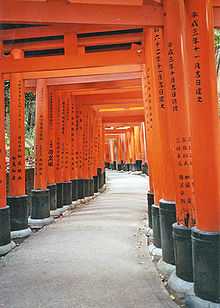Inari shrine
An Inari shrine (稲荷神社 Inari Jinja) is a shinto shrine to worship the god Inari. There are many Inari shrines in Japan. The deity is worshiped also in some Buddhist temples.
Shrines and offerings

Inari is a popular deity with shrines and Buddhist temples located throughout most of Japan. According to a 1985 survey by the National Association of Shinto Shrines, 32,000 shrines — more than one-third of Shinto shrines in Japan — are dedicated to Inari.[1] This number includes only Shinto shrines with full-time resident priests; if small roadside or field shrines, shrines kept in a home or corporate office, smaller shrines without full-time resident priests, and Buddhist temples were included, the number would increase by at least an order of magnitude.[2]
The entrance to an Inari shrine is usually marked by one or more vermilion torii and some statues of kitsune, which are often adorned with red yodarekake (votive bibs) by worshippers out of respect. This red color has come to be identified with Inari, because of the prevalence of its use among Inari shrines and their torii.[3] The main shrine is the Fushimi Inari Shrine in Fushimi, Kyoto, Japan, where the paths up the shrine hill are marked in this fashion.
The kitsune statues are at times taken for a form of Inari, and they typically come in pairs, representing a male and a female.[4] These fox statues hold a symbolic item in their mouths or beneath a front paw — most often a jewel and a key, but a sheaf of rice, a scroll, or a fox cub are all common. Almost all Inari shrines, no matter how small, will feature at least a pair of these statues, usually flanking or on the altar or in front of the main sanctuary.[4] The statues are rarely realistic; they are typically stylized, portraying a seated animal with its tail in the air looking forward. Despite these common characteristics, the statues are highly individual in nature; no two are quite the same.[5][6]

Offerings of rice, sake, and other food are given at the shrine to appease and please these kitsune messengers, who are then expected to plead with Inari on the worshipper's behalf.[7] Inari-zushi, a Japanese sushi roll of rice-packed fried tofu, is another popular offering. Fried tofu is believed to be a favorite food of Japanese foxes, and an Inari-zushi roll has pointed corners that resemble fox ears, thus reinforcing the association.[8] Priests do not normally offer these foods to the deity, but it is common for shops that line the approach to an Inari shrine to sell fried tofu for devotees to offer.[9] Fox statues are often offered to Inari shrines by worshippers, and on occasion a stuffed and mounted fox is presented to a temple. At one time, some temples were home to live foxes that were venerated, but this is not current practice.[10] The Toyokawa Inari temple has a sign noting that live foxes were kept on site in the 1920s.
Notable shrines
Shinto
The following are dedicated to the worship of Inari.
- Fushimi Inari-taisha - Fushimi, Kyoto — Sōhonsha (the head shrine) of Inari shrines.
- Kasama Inari Shrine - Kasama, Ibaraki
- Namiyoke Inari Shrine - Chūō, Tokyo
- Taikodani Inari Shrine - Tsuwano, Shimane
- Shiwa Inari Shrine - Shiwa, Iwate
- Takahashi Inari Shrine - Kumamoto, Kumamoto
- Tamatsukuri Inari Shrine - Chūō, Osaka
- Takekoma Inari Shrine - Iwanuma, Miyagi — the second-oldest Inari shrine.
- Yakyu Inari Shrine - Higashi-Murayama, Saitama
- Yūtoku Inari Shrine - Kashima, Saga
Buddhist
The following are Buddhist temples dedicated to the worship of Inari.
- Toyokawa Inari - Toyokawa, Aichi — Sōhonzan (the head temple) of Inari temples.
- Saijo Inari - Okayama, Okayama
See also
| Wikimedia Commons has media related to Inari-jinja. |
- Hachiman shrine – second most
Notes
References
- Smyers, Karen Ann. (1999). The Fox and the Jewel: Shared and Private Meanings in Contemporary Japanese Inari Worship. Honolulu: University of Hawaii Press. 10-ISBN 0824820584/13-ISBN 9780824820589; 10-ISBN 0824821025/13-ISBN 9780824821029; OCLC 39523475
- Okada, Shōji. "Reii-jin to Sūkei-kō." Nihon Shūkyō Jiten, 1985
- Gorai, Shigeru. Inari Shinkō no Kenkyū. Okayama: Sanyō Shimbunsha, 1985
- Hearn, Lafcadio. Glimpses of Unfamiliar Japan. Project Gutenberg e-text edition, 2005. 152-153. Retrieved on February 19, 2007.